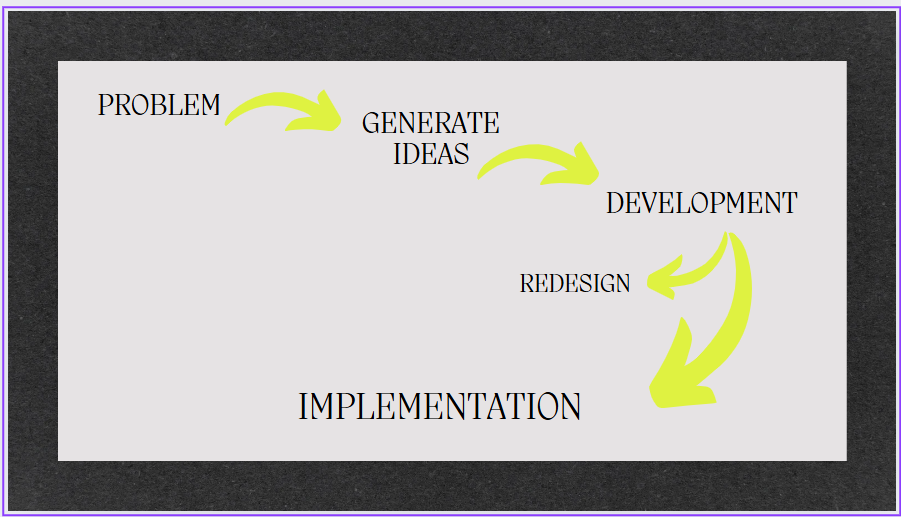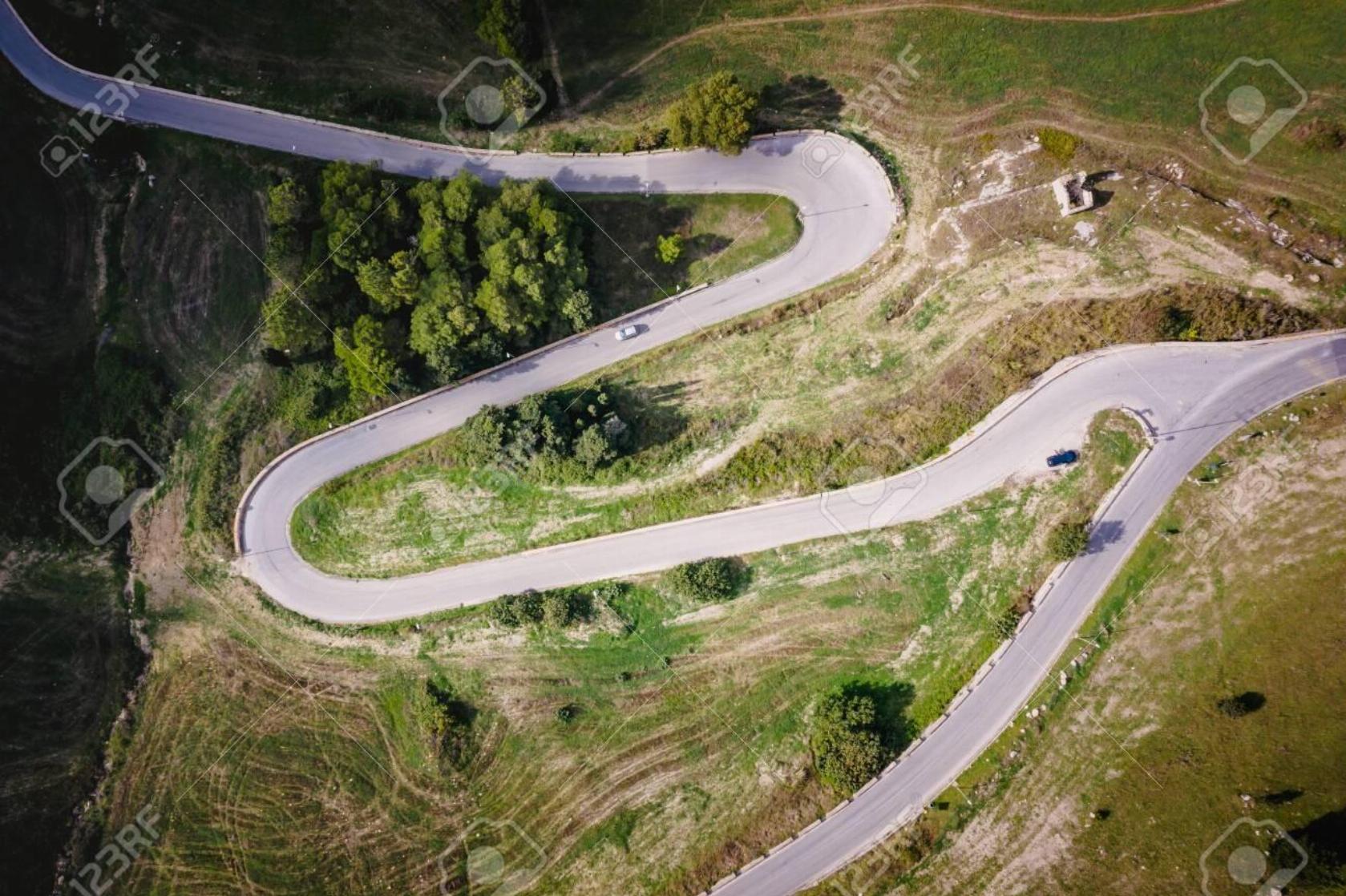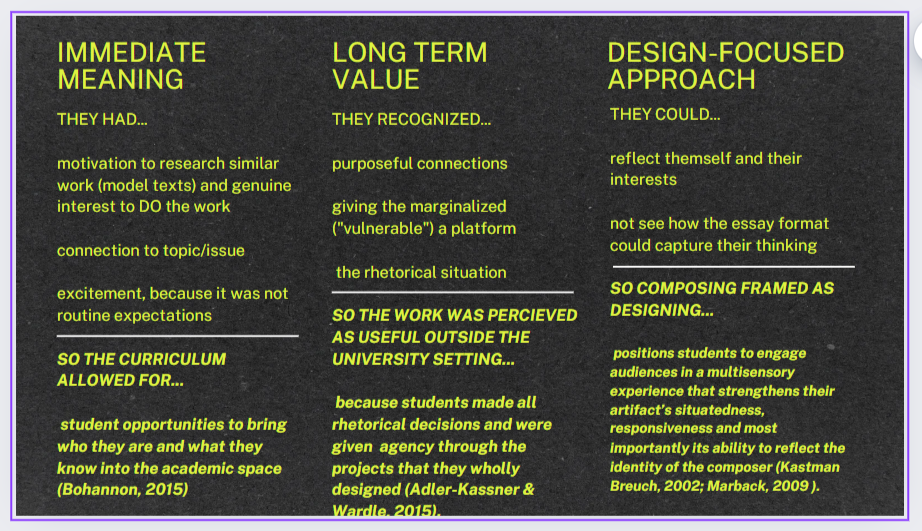
sites of learning
FYC instructors needed supports to modernize their practice. They also needed a comprehensive resource from which they might learn multimodal pedagogy- a viable means to make FYC relevant and appealing to students (Khadka & Lee,2018, Leveranz, 2014; Shipka, 2005; Palmeri, 2012). However, I did not believe that my dissertation project, despite it being a public website, would be THE answer to instructors’ needs. It forced me to find an answer to a problem I had been wrestling with for months. Who was the audience for my project? Was it FYC instructors? Was it my committee? Or was it someone else?
The work was required to meet my doctoral program’s benchmark, but I wanted the project to have a broader impact. If a Design-Focused Approach to FYC was meant to support instructors to develop their own multimodal pedagogy, then my answer was obvious. There was not just one, exclusive answer; instead, I could reconcile the intended audiences.
It took many attempts to plan an appropriate layout for the website. I worked hard to organize the pages and elements of the site. At first, I worked on a predictable format where the dissertation committee was my targeted audience and writing instructors were a peripheral consideration:
- Course Description (to State the Problem and connect with instructors)
- Academic Resources (to function as a Literature Review and provide materials)
- Sample Lessons (to illustrate Methods and provide instructional resources)
- Samples of Student Work (to evidence Findings and provide examples of deliverables)
- Case Studies (to state Implications and prove the effectiveness of the approach)
As shown in the parenthetical justifications for each section, I could not free myself from the expected format of a dissertation. I used the features of the genre to structure my website, which became a manifestation of what scholar Elizabeth Wardle calls a “mutt genre- genres that do not respond to rhetorical situations requiring communication in order to accomplish a purpose that is meaningful to the author.” In her 2009 CCCC’s article, “Mutt Genres” and the Goals of FYC: Can We Help Students Write the Goals of the University?” she goes on to assert that:
Exigence, then, plays a central role in recent genre theory. Genres arise when particular exigencies are encountered repeatedly; yet each time an exigence arises, people must be attuned to the specifics of the current situation in order to employ the institutionalized features of the genre effectively—or, in some cases, THROW THEM OUT…genre features arise as a result of specific and complex rhetorical situations, they continue if they are effective in responding to those rhetorical situations, and they are changed when they are no longer effective in meeting the needs of those rhetorical situations.
Audio process capture 1
LINK to IDEATING BLOG POST– inspiration from www.greatminds.org
audio process capture 2
Just as Wardle articulated, my project was a “specific and complex rhetorical situation.” It was never going to be just a dissertation. Up to this point in my process, I had written about my materials for a DFA exclusively for my dissertation committee, so that I could show how the curriculum worked in a FYC classroom. As much as I’d like to believe that an implementation guide would fill a gap in the field of composition studies and make it a valuable academic contribution, it was quickly losing meaning for me. My frustrations were only increased by my unsuccessful attempt to include the elements of a “How To” guide structured as dissertation chapters on a website! A guide would certainly provide a place where instructors might begin their transition into multimodal pedagogy, but it was not shaping up to the contribution that I wanted to make. Instead, I hoped that the curriculum and samples of student work would generate excitement and fresh new ideas. Multimodal pedagogy, especially framed as a Design-Focused Approach has value, because it is based on flexibility and innovation. It was the unknown- the possibilities, that held meaning for me.
audio process capture 3
As I continued to plan the project, I abandoned the idea of a “How To” approach to multimodal implementation in FYC. I wanted to get beyond the assumption that there was a “correct” way to do it and instead work to show flexibility and innovation. There were many possible methods and strategies to prepare students with the tools they needed to be effective writers. This situation would not be different.
audio process capture 4
i digress…

I think that it is a critical point in the narrative to admit despite the design process helping me to write the dissertation project, it did not create an easy storyline to follow. Defining the problem spurred yet more problems and I had to generate ideas for how to solve each of them. Inevitably, I found myself redefining the project and all the problems that came with it! The process demanded that I move back and forth between defining, ideating, planning and prototyping. Although this only reifies the flexibility that a Design-Focused Approach brings to writing/designing, this recursive quality makes telling the story incredibly tricky. I want to take you through my journey with ease, but as the famous opera singer Beverly Sills said, “there are no shortcuts to any place worth going”
mapping meaning
After I pleaded my case to my dissertation chair, she agreed that the project should be a reflection of me- just like the work I encouraged of my FYC students. So, it was back to the drawing board. No more guide. No more dissertation committee.
I got an idea about retaining space on the site for the course materials as well as the samples of student work, but to function as sites of content from which instructors could tease out their own ideas. It was as though I would present features of the course and ask them what would you do?
Even though the question I asked was inherently open-ended, I was finally going to make a thing- a thing that had meaning for me as well as a thing from which others could make meaning.
I was asked to present my dissertation methods to The Teaching of Writing graduate course and was also accepted to WSU’s 2023 Teaching of Writing Conference. This put me in a situation that forced me to determine a way to organize student work from the DFA to FYC and more importantly what it illustrated about the multimodal pedagogy. Noelle’s work was definitely what I wanted to feature for a case study, so I began with their materials.
I mined their projects and Design Journals, the research interview I conducted with Noelle, and a special video segment we recorded for the fall 2022 Composition Learning Community Showcase. I employed methods similar to Stephen Ferucci and Susan DeRosa, in a chapter based on their study, “Multimodality, Transfer and Rhetorical Awareness: Analyzing the Choices of Undergraduate Writers,” In Khadka and Lee’s Bridging the Multimodal Gap: From Theory to Practice. First, I looked over the student’s work. Then, I read Noelle’s correlating Design Journal 5 and Project Builder 3 to analyze how they reflected on their work, especially with regard to addressing their targeted audience and the affordances of their projects’ modalities. During both of the recordings (the interview and CLC Showcase segment), Noelle was explicit about the intentional choices that they made and how each decision held meaning for them in their redesign project (Making a Thing Better). Noelle admitted:
In Project 4, I interviewed my friend, from GVSU,.. who is Korean and Black… students [like her] may not have a platform to speak their experience. It was meaningful for me, because my sisters are mixed, so we would always have conversations about how they never really felt accepted in a social situation, a racial social situation. So, to bring that into a project- to really talk about it- to have her thoughts about her experience was, like, WHOA!
I recognized the meaning Noelle felt in choosing to interview their friend, Aniya. The video recording had modal affordance; the audience could see her facial expression and gesture as they heard Aniya talk through the sensitive subject. The medium captured Aniya’s humanity and experiences through the honest feelings she shared on a public “platform.” Connecting Noelle’s comment about what was meaningful with how she perceived the term meaningful was critical for my analysis. When I asked Noelle to define the phrase “meaningful writing,” they shared,
“Immediately I think about things that matter…the writing is something that has purpose…”and “…the way that I took CARE of that topic…”
Noelle used the phrase, “things that matter” and the terms, “purpose” and “care.” I concluded that there was a distinction between other kinds of writing and “meaningful writing” for them. Noelle’s 4th project was a vehicle for agency- to engage with the subject matter in personal ways that illustrated their position in the larger conversation. Noelle was able to invite Aniya into the conversation and by doing so also extended an invitation to a broader audience to generate human connection.
Ferucci and DeRosa attest to the connection between student’s modal choices and the potential to resonate with their audience:
…that when students incorporate different modes into
their alphabetic texts, it is in those spaces that extend beyond print
where they are able to connect most strongly with their audience, or,
at least, gesture in complex ways towards that audience… suggest that students’ awareness of these other elements affects how they negotiate the rhetorical situations for their writing and make choices, it seems, with a keener eye towards who would CARE, why they’d care, and how they might be moved by the text and its message. Audience becomes a complex concept (instead of writers writing to the teacher or to “everyone” or “anyone”) they must wrangle with—one that requires writers’ use of rhetorical knowledge and critical-analysis skills that enable them to make conscious choices and be able to articulate why they made them for a particular audience.
Noelle was able to make all rhetorical decisions in the project. As a result, they targeted a real audience, not just me (the instructor). Having such agency allowed Noelle to craft an authentic conversation that mattered in the bigger picture, not just in the space of the classroom. Furthermore, such work established Noelle’s credibility as the speaker. The project exhibited rhetorical responsibility and flexibility and a picture of the effectiveness of the curriculum began to emerge.
As I had some clear ideas about the mechanics of how the assignments guided students toward the learning outcomes, I drafted preliminary work on Noelle’s case study for the website on a Canva presentation (see slide below). After presenting the material to the graduate course and the conference, I could transition the findings to the website.

Below, you can listen to my thoughts about key features and menu items for the site.
audio capture 5
next blog-
Try This, Is it Still Good? Models and Quality Control.
another curve in the road,
but it was very scenic